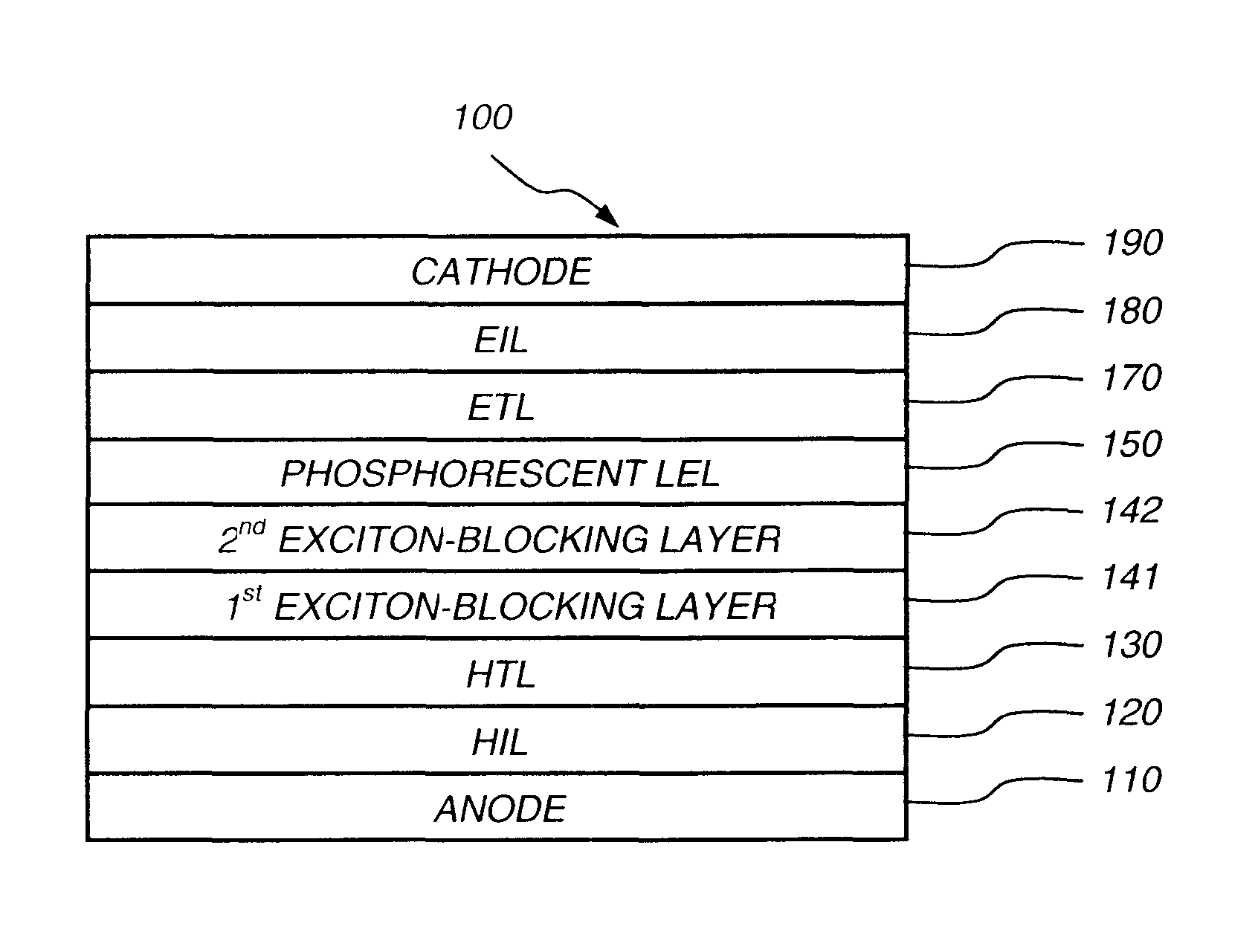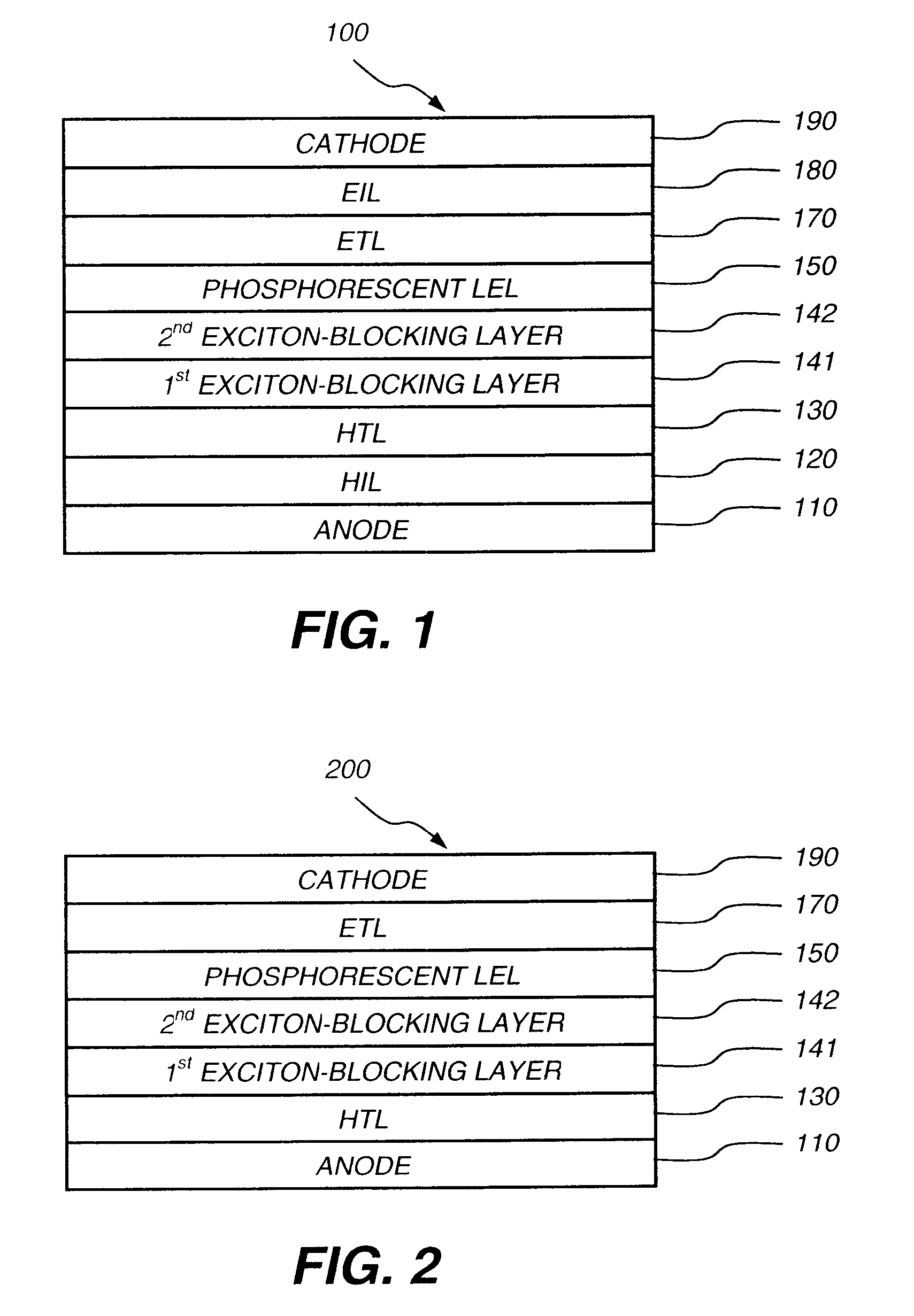Phosphorescent oled having double exciton-blocking layers
a phosphorescent oled and exciton-blocking technology, which is applied in the direction of discharge tube luminescnet screens, natural mineral layered products, other domestic articles, etc., can solve the problems of not being able to fully block the triplet exciton diffusion and affecting the operation li
- Summary
- Abstract
- Description
- Claims
- Application Information
AI Technical Summary
Benefits of technology
Problems solved by technology
Method used
Image
Examples
examples
[0315]The following examples are presented for a further understanding of the present invention. The reduction potential and the oxidation potential of the materials were measured using a Model CHI660 electrochemical analyzer (CH Instruments, Inc., Austin, Tex.) with the method as discussed before. During the fabrication of OLEDs, the thickness of the organic layers and the doping concentrations were controlled and measured in situ using calibrated thickness monitors built in an evaporation system (Made by Trovato Mfg., Inc., Fairport, N.Y.). The EL characteristics of all the fabricated devices were evaluated using a constant current source (KEITHLEY 2400 SourceMeter, made by Keithley Instruments, Inc., Cleveland, Ohio) and a photometer (PHOTO RESEARCH SpectraScan PR 650, made by Photo Research, Inc., Chatsworth, Calif.) at room temperature. Operational lifetime (or stability) of the devices was tested at the loom temperature and at an initial luminance of 1,000 cd / m2 by driving a c...
examples 4-6
[0341]A comparative phosphorescent OLED (Device 4) is fabricated with the same method and the same layer structure as Example 1, except that the LEL is a TPBI layer doped with 7% of Ir(ppy)3 by volume.
[0342]Device 4 is denoted as: ITO / 95 nm NPB / 20 nm TPBI:7 vol. % Ir(ppy)3 / 40 nm Bphen / 1 nm LiF / 100 nm Al. The EL performance of the device is summarized in Table 1, and its EL spectrum is shown in FIG. 6.
[0343]Another comparative phosphorescent OLED (Device 5) is fabricated with the same method and the same layer structure as Example 2, except that the LEL is a TPBI layer doped with 7% of Ir(ppy)3 by volume.
[0344]Device 5 is denoted as: ITO / 85 nm NPB / 10 nm TCTA / 20 nm TPBI:7 vol. % Ir(ppy)3 / 40 nm Bphen / 1 nm LiF / 100 nm Al. The EL performance of the device is summarized in Table 1, and its EL spectrum is shown in FIG. 6.
[0345]An inventive phosphorescent OLED (Device 6) is fabricated with the same method and the same layer structure as Example 3, except that the LEL is a TPBI layer doped wi...
examples 7-8
[0349]A comparative phosphorescent OLED (Device 7) is constructed in the same manner as that of Example 1. The layer structure is:
[0350]a) an HTL, 10 nm thick, including hexaazatriphenylene hexacarbonitrile (HAT-CN);
[0351]b) a HTL, 75 nm thick, including NPB;
[0352]c) a 1st EBL, 10 nm thick, including TCTA;
[0353]e) a LEL, 20 nm thick, including Bphen doped with 7% of Ir(ppy)2(cou1) by volume;
[0354]f) an ETL, 50 nm thick, including Bphen;
[0355]g) an EIL, 2 nm thick, including Formula (T-1); and
[0356]h) a cathode: approximately 100 nm thick, including Al.
[0357]Device 7 is denoted as: ITO / 10 nm HAT-CN / 75 nm NPB / 10 nm TCTA / 20 nm Bphen:7% Ir(ppy)2(cou1) / 50 nm Bphen / 2 nm (T-1) / 100 nm Al. The EL performance of the device is summarized in Table 2, and its EL spectrum is shown in FIG. 7.
[0358]An inventive phosphorescent OLED (Device 8) is constructed in the same manner and the same layer structure as that of Example 7, except that a 2nd EXBL is inserted between the 1st EXBL and the LEL layer....
PUM
| Property | Measurement | Unit |
|---|---|---|
| thickness | aaaaa | aaaaa |
| thickness | aaaaa | aaaaa |
| thick | aaaaa | aaaaa |
Abstract
Description
Claims
Application Information
 Login to View More
Login to View More - R&D
- Intellectual Property
- Life Sciences
- Materials
- Tech Scout
- Unparalleled Data Quality
- Higher Quality Content
- 60% Fewer Hallucinations
Browse by: Latest US Patents, China's latest patents, Technical Efficacy Thesaurus, Application Domain, Technology Topic, Popular Technical Reports.
© 2025 PatSnap. All rights reserved.Legal|Privacy policy|Modern Slavery Act Transparency Statement|Sitemap|About US| Contact US: help@patsnap.com



